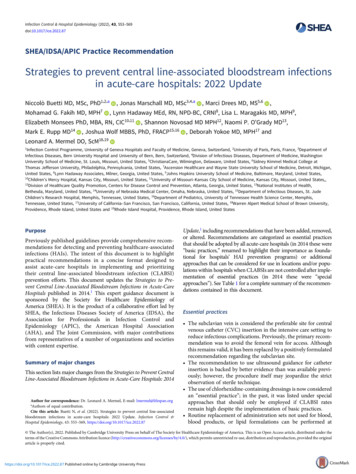
Transcription
Infection Control & Hospital Epidemiology (2022), 43, 553–569doi:10.1017/ice.2022.87SHEA/IDSA/APIC Practice RecommendationStrategies to prevent central line-associated bloodstream infectionsin acute-care hospitals: 2022 UpdateNiccolò Buetti MD, MSc, PhD1,2,aMohamad G. Fakih MD, MPH7, Jonas Marschall MD, MSc3,4,a,, Lynn Hadaway MEd, RN, NPD-BC, CRNI8, Lisa L. Maragakis MD, MPH9,Elizabeth Monsees PhD, MBA, RN, CIC10,11Mark E. Rupp MD14, Marci Drees MD, MS5,6, Shannon Novosad MD MPH12, Naomi P. O’Grady MD13,, Joshua Wolf MBBS, PhD, FRACP15,16, Deborah Yokoe MD, MPH17 and18,19Leonard A. Mermel DO, ScM1Infection Control Programme, University of Geneva Hospitals and Faculty of Medicine, Geneva, Switzerland, 2University of Paris, Paris, France, 3Department ofInfectious Diseases, Bern University Hospital and University of Bern, Bern, Switzerland, 4Division of Infectious Diseases, Department of Medicine, WashingtonUniversity School of Medicine, St. Louis, Missouri, United States, 5ChristianaCare, Wilmington, Delaware, United States, 6Sidney Kimmel Medical College atThomas Jefferson University, Philadelphia, Pennsylvania, United States, 7Ascension Healthcare and Wayne State University School of Medicine, Detroit, Michigan,United States, 8Lynn Hadaway Associates, Milner, Georgia, United States, 9Johns Hopkins University School of Medicine, Baltimore, Maryland, United States,10Children’s Mercy Hospital, Kansas City, Missouri, United States, 11University of Missouri–Kansas City School of Medicine, Kansas City, Missouri, United States,,12Division of Healthcare Quality Promotion, Centers for Disease Control and Prevention, Atlanta, Georgia, United States, 13National Institutes of Health,Bethesda, Maryland, United States, 14University of Nebraska Medical Center, Omaha, Nebraska, United States, 15Department of Infectious Diseases, St. JudeChildren’s Research Hospital, Memphis, Tennessee, United States, 16Department of Pediatrics, University of Tennessee Health Science Center, Memphis,Tennessee, United States, 17University of California–San Francisco, San Francisco, California, United States, 18Warren Alpert Medical School of Brown University,Providence, Rhode Island, United States and 19Rhode Island Hospital, Providence, Rhode Island, United StatesPurposePreviously published guidelines provide comprehensive recommendations for detecting and preventing healthcare-associatedinfections (HAIs). The intent of this document is to highlightpractical recommendations in a concise format designed toassist acute-care hospitals in implementing and prioritizingtheir central line-associated bloodstream infection (CLABSI)prevention efforts. This document updates the Strategies to Prevent Central Line-Associated Bloodstream Infections in Acute-CareHospitals published in 2014.1 This expert guidance document issponsored by the Society for Healthcare Epidemiology ofAmerica (SHEA). It is the product of a collaborative effort led bySHEA, the Infectious Diseases Society of America (IDSA), theAssociation for Professionals in Infection Control andEpidemiology (APIC), the American Hospital Association(AHA), and The Joint Commission, with major contributionsfrom representatives of a number of organizations and societieswith content expertise.Summary of major changesThis section lists major changes from the Strategies to Prevent CentralLine-Associated Bloodstream Infections in Acute-Care Hospitals: 2014Author for correspondence: Dr. Leonard A. Mermel, E-mail: lmermel@lifespan.orgaAuthors of equal contribution.Cite this article: Buetti N, et al. (2022). Strategies to prevent central line-associatedbloodstream infections in acute-care hospitals: 2022 Update. Infection Control &Hospital Epidemiology, 43: 553–569, https://doi.org/10.1017/ice.2022.87Update,1 including recommendations that have been added, removed,or altered. Recommendations are categorized as essential practicesthat should be adopted by all acute-care hospitals (in 2014 these were“basic practices,” renamed to highlight their importance as foundational for hospitals’ HAI prevention programs) or additionalapproaches that can be considered for use in locations and/or populations within hospitals when CLABSIs are not controlled after implementation of essential practices (in 2014 these were “specialapproaches”). See Table 1 for a complete summary of the recommendations contained in this document.Essential practices The subclavian vein is considered the preferable site for centralvenous catheter (CVC) insertion in the intensive care setting toreduce infectious complications. Previously, the primary recommendation was to avoid the femoral vein for access. Althoughthis remains valid, it has been replaced by a positively formulatedrecommendation regarding the subclavian site. The recommendation to use ultrasound guidance for catheterinsertion is backed by better evidence than was available previously; however, the procedure itself may jeopardize the strictobservation of sterile technique. The use of chlorhexidine-containing dressings is now consideredan “essential practice”; in the past, it was listed under specialapproaches that should only be employed if CLABSI ratesremain high despite the implementation of basic practices. Routine replacement of administration sets not used for blood,blood products, or lipid formulations can be performed at The Author(s), 2022. Published by Cambridge University Press on behalf of The Society for Healthcare Epidemiology of America. This is an Open Access article, distributed under theterms of the Creative Commons Attribution licence (http://creativecommons.org/licenses/by/4.0/), which permits unrestricted re-use, distribution and reproduction, provided the originalarticle is properly cited.https://doi.org/10.1017/ice.2022.87 Published online by Cambridge University Press
554Niccolò Buetti et alTable 1. Summary of Recommendations to Prevent CLABSIEssential PracticesBefore insertion1. Provide easy access to an evidence-based list of indications for CVC use to minimize unnecessary CVC placement (Quality of Evidence: LOW)2. Require education and competency assessment of HCP involved in insertion, care, and maintenance of CVCs about CLABSI prevention (Quality ofEvidence: MODERATE)74–783. Bathe ICU patients aged 2 months with a chlorhexidine preparation on a daily basis (Quality of Evidence: HIGH)86–90At insertion1. In ICU and non-ICU settings, a facility should have a process in place, such as a checklist, to ensure adherence to infection prevention practices at thetime of CVC insertion (Quality of Evidence: MODERATE)1012. Perform hand hygiene prior to catheter insertion or manipulation (Quality of Evidence: MODERATE)102–1073. The subclavian site is preferred to reduce infectious complications when the catheter is placed in the ICU setting (Quality of Evidence: HIGH)33,37,108–1104. Use an all-inclusive catheter cart or kit (Quality of Evidence: MODERATE)1185. Use ultrasound guidance for catheter insertion (Quality of Evidence: HIGH)119,1206. Use maximum sterile barrier precautions during CVC insertion (Quality of Evidence: MODERATE)123–1287. Use an alcoholic chlorhexidine antiseptic for skin preparation (Quality of Evidence: HIGH)42,129–134After insertion1. Ensure appropriate nurse-to-patient ratio and limit use of float nurses in ICUs (Quality of Evidence: HIGH)34,352. Use chlorhexidine-containing dressings for CVCs in patients over 2 months of age (Quality of Evidence: HIGH)45,135–1423. For non-tunneled CVCs in adults and children, change transparent dressings and perform site care with a chlorhexidine-based antiseptic at least every 7days or immediately if the dressing is soiled, loose, or damp. Change gauze dressings every 2 days or earlier if the dressing is soiled, loose, or damp(Quality of Evidence: MODERATE)145–1484. Disinfect catheter hubs, needleless connectors, and injection ports before accessing the catheter (Quality of Evidence: MODERATE)150–1545. Remove nonessential catheters (Quality of Evidence: MODERATE)6. Routine replacement of administration sets not used for blood, blood products, or lipid formulations can be performed at intervals up to 7 days (Qualityof Evidence: HIGH)1647. Perform surveillance for CLABSI in ICU and non-ICU settings (Quality of Evidence: HIGH)13,165,166Additional Approaches1. Use antiseptic- or antimicrobial-impregnated CVCs (Quality of Evidence: HIGH in adult patients38,39,169–171 and Quality of Evidence: MODERATE in pediatricpatients)172,1732. Use antimicrobial lock therapy for long-term CVCs (Quality of Evidence: HIGH)177–1843. Use recombinant tissue plasminogen activating factor (rt-PA) once weekly after hemodialysis in patients undergoing hemodialysis through a CVC (Qualityof Evidence: HIGH)1924. Utilize infusion or vascular access teams for reducing CLABSI rates (Quality of Evidence: LOW)193,1945. Use antimicrobial ointments for hemodialysis catheter insertion sites (Quality of Evidence: HIGH)197–2016. Use an antiseptic-containing hub/connector cap/port protector to cover connectors (Quality of Evidence: MODERATE)202–208Approaches that Should Not Be Considered a Routine Part of CLABSI Prevention1. Do not use antimicrobial prophylaxis for short-term or tunneled catheter insertion or while catheters are in situ (Quality of Evidence: HIGH)209–2132. Do not routinely replace CVCs or arterial catheters (Quality of Evidence: HIGH)214Unresolved Issues1.2.3.4.5.6.7.Routine use of needleless connectors as a CLABSI prevention strategy before an assessment of risks, benefits, and education regarding proper use215–219Surveillance of other types of catheters (eg, peripheral arterial or peripheral venous catheters)11,21,22Standard, nonantimicrobial transparent dressings and CLABSI risk.The impact of using chlorhexidine-based products on bacterial resistance to chlorhexidineSutureless securementImpact of silver zeolite-impregnated umbilical catheters in preterm infants (applicable in countries where it is approved for use in children)227Necessity of mechanical disinfection of a catheter hub, needleless connector, and injection port before accessing the catheter when antiseptic-containingcaps are being usedNote. CLABSI, central line-associated bloodstream infection; CVC, central venous catheter; HCP, healthcare personnel; ICU, intensive care unit.intervals of up to 7 days. Previously, this interval was no longerthan 4 days. Sutureless securement of catheters was not discussed in the previous version of this section.Additional approaches Antimicrobial ointment for the catheter site, which is gearedtoward the population of hemodialysis patients, has been movedto “additional practices” given the focus on a specific population. Despite currently being supported by high-level evidence,antiseptic-containing caps remain an “additional practice”because they are not considered superior to the manual disinfection, an essential practice. The importance of infusion teams has been highlighted bylisting it under “additional practices” (previously 2022.87 Published online by Cambridge University PressIntended useThis document was developed following the process outlined in theHandbook for SHEA-Sponsored Guidelines and Expert GuidanceDocuments.2 No guideline or expert guidance document cananticipate all clinical situations, and this document is not meantto be a substitute for individual clinical judgment by qualifiedprofessionals.This document is based on a synthesis of evidence, theoreticalrationale, current practices, practical considerations, writinggroup consensus, and consideration of potential harm, where
Infection Control & Hospital Epidemiology555Table 2. Quality of EvidenceaCategoryDefinitionHIGHHighly confident that the true effect lies close to that of the estimated size and direction of the effect. Evidence is rated as high quality whenthere are a wide range of studies with no major limitations, there is little variation between studies, and the summary estimate has a narrowconfidence interval.MODERATE The true effect is likely to be close to the estimated size and direction of the effect, but there is a possibility that it is substantially different.Evidence is rated as moderate quality when there are only a few studies and some have limitations but not major flaws, there is somevariation between studies, and/or the confidence interval of the summary estimate is wide.LOWThe true effect may be substantially different from the estimated size and direction of the effect. Evidence is rated as low quality whensupporting studies have major flaws, there is important variation between studies, the confidence interval of the summary estimate is verywide, and/or there are no rigorous studies.aBased on the CDC Healthcare Infection Control Practices Advisory Committee (HICPAC) “Update to the Centers for Disease Control and Prevention and the Healthcare Infection ControlPractices Advisory Committee Recommendations Categorization Scheme for Infection Control and Prevention Guideline Recommendations” (October 2019), the Grades of Recommendation,Assessment, Development, and Evaluation (GRADE),265 and the Canadian Task Force on Preventive Health Care.266applicable. A summary list of recommendations is provided alongwith their relevant rationales (see Table 1).MethodsSHEA recruited 3 subject-matter experts in the prevention ofCLABSI to lead the panel of members representing theCompendium partnering organizations: SHEA, the InfectiousDiseases Society of America (IDSA), the Association forProfessionals in Infection Control and Epidemiology (APIC),the American Hospital Association (AHA), and The JointCommission, as well as representation by the Centers forDisease Control and Prevention (CDC).SHEA utilized a consultant medical librarian, who workedwith each panel to develop a comprehensive search strategyfor PubMed and Embase (January 2012–July 2019; updated toAugust 2021). Articles’ abstracts were reviewed by panelmembers in a double-blind fashion using the abstract management software, Covidence (Melbourne, Australia), and subsequently reviewed as full text. The Compendium LeadAuthors group voted to update the literature findings, and thelibrarian reran the search to update it to August 2021. Panelmembers reviewed the abstracts of these articles via Covidenceand incorporated relevant references.Recommendations resulting from this literature review processwere classified based on the quality of evidence and the balancebetween desirable and potential for undesirable effects of various interventions (see Table 2). Panel members met via videoconference to discuss literature findings; recommendations;quality of evidence for these recommendations; and classification as essential practices, additional approaches, or unresolvedissues. Panel members reviewed and approved the documentand its recommendations.The Compendium Expert Panel, made up of members withbroad healthcare epidemiology and infection prevention expertise,reviewed the draft manuscript after consensus had been reached bywriting panel members.Following review and approval by the Expert Panel, the 5 partnering organizations, stakeholder organizations, and the CDCreviewed the document. Prior to dissemination, the guidancedocument was reviewed and approved by the SHEA GuidelinesCommittee, the IDSA Standards and Practice GuidelinesCommittee, and the Boards of SHEA, IDSA, APIC, AHA, andThe Joint Commission.https://doi.org/10.1017/ice.2022.87 Published online by Cambridge University PressAll panel members complied with SHEA and IDSA policies onconflict-of-interest disclosure.Section 1: Rationale and statements of concernBurden of outcomes associated with hospital-acquiredCLABSI1. Increased length of hospital stay3–62. Increased cost. The adjusted variable costs for patients withCLABSI were 32,000 (2010 US dollars) higher on average thanfor patients without CLABSI73. Increased morbidity and mortality8Risk factors for CLABSI1. Patients at risk for CLABSI in acute-care facilities are thosewith a CVC in place:a. Intensive care unit (ICU) population: The risk of CLABSI inICU patients is high. Reasons for this include the frequentinsertion of multiple catheters9,10; the use of specific types ofcatheters that are almost exclusively inserted in ICU patientsand associated with substantial risk (eg, pulmonary artery catheters with catheter introducers); and the fact that catheters arefrequently placed in emergency circumstances, repeatedlyaccessed each day, and often needed for extended periods.11,12b. Non-ICU population: Although the primary focus of attention over the last 20 years has been the ICU setting, mostCLABSIs occur in hospital units outside the ICU or in outpatients.13–172. Infection prevention and control efforts should include othervulnerable populations such as patients receiving hemodialysisthrough catheters,18 intraoperative patients,19 and oncologypatients.203. In addition to CVCs, short-term peripheral catheters,21 peripherally inserted central venous catheters (PICCs), midline catheters, and peripheral arterial catheters also carry a risk ofinfection.224. Independent risk factors for CLABSI (in at least 2 publishedstudies)23–45a. Prolonged hospitalization before catheterizationb. Prolonged duration of catheterizationc. Heavy microbial colonization at insertion sited. Heavy microbial colonization of the catheter hube. Multilumen catheters
556Niccolò Buetti et alf.g.h.i.j.k.l.Concurrent cathetersNeutropeniaBody mass index (BMI) 40Prematurity (ie, early gestational age)Reduced nurse-to-patient ratio in the ICUParenteral nutritionSubstandard catheter care (eg, excessive manipulation ofthe catheter)m. Transfusion of blood products (in children)Section 2: Background on detection of CLABSISurveillance methods and definitions for CLABSI1. Use consistent surveillance methods and definitions to allowcomparison to benchmark data.2. Refer to the National Healthcare Safety Network (NHSN)Patient Safety Component Manual for information on theappropriate surveillance methodology, including informationabout blood specimen collection and surveillance definitions of CLABSIs. The relevant chapter of the manual is“Chapter 4: Bloodstream Infection Event (Central LineAssociated Bloodstream Infection and Non-Central LineAssociated Bloodstream Infection).”46a. Recent data suggest that interrater reliability using NHSNdefinitions is lower than expected.47–50 This may also affectthe reliability of public reporting.b. The NHSN surveillance definition for CLABSI is differentthan the clinical definition for catheter-related bloodstreaminfection (CRBSI). The latter is subject to various factors (eg,laboratory capabilities, catheter removal, and submitting thecatheter tip for culture).51 The evidence presented hereincludes studies that used either CLABSI or CRBSI as an outcome measure and the lesser accuracy of CLABSI mayimpact the validity of the evidence.Section 3: Background on prevention of CLABSISummary of existing guidelines and recommendations1. Several governmental, public health, and professional organizations have published evidence-based guidelines and/orimplementation aids regarding the prevention of CLABSIincluding the following:a. Healthcare Infection Control Practices Advisory Committee(HICPAC), Centers for Disease Control and Prevention(CDC)52,53b. Institute for Healthcare Improvement (IHI)54c. Agency for Healthcare Research and Quality, Making HealthCare Safer55d. American Pediatric Surgical Association, Outcomes andClinical Trials Committee56e. The Joint Commission57f. APIC, Implementation Guide to Preventing Central LineAssociated Bloodstream Infections58g. Infusion Nurses Society, Infusion Nursing Standards ofPractice592. The recommendations in this document focus on CVCs unlessnoted otherwise. These recommendations:a. Are not stratified based on the type of catheter (eg, tunneled,implanted, cuffed, non-cuffed catheter, dialysis catheter).https://doi.org/10.1017/ice.2022.87 Published online by Cambridge University Pressb. May not be applicable in their entirety for preventionof bloodstream infections with other intravasculardevices.Infrastructure requirementsFacilities undertaking CLABSI interventions should have the following elements in place:1. An adequately staffed infection prevention and control program responsible for identifying patients who meet the surveillance definition for CLABSI.2. Infection prevention staff and, preferably, information technology support to collect and calculate catheter days as a denominator when computing rates of CLABSI and patient days toallow calculation of CVC utilization. Catheter days from information systems should be validated against a manual method,with a margin of error no greater than 5%.60–623. Resources to provide appropriate education and training.4. Adequate laboratory support for timely processing of specimens and reporting of results, as specified by the supervisorof the surveillance program.Section 4: Recommended strategies to prevent CLABSIRecommendations are categorized as either (1) essential practices that should be adopted by all acute-care hospitals or(2) additional approaches that can be considered in locationsand/or populations within hospitals when CLABSIs are not controlled by use of essential practices. Essential practices includerecommendations in which the potential to affect CLABSIrisk clearly outweighs the potential for undesirable effects.Additional approaches include recommendations in which theintervention is likely to reduce CLABSI risk but there is concernabout the risks for undesirable outcomes, recommendations forwhich the quality of evidence is low, recommendations inwhich cost-to-benefit ratio may be high, or recommendationsin which evidence supports the impact of the intervention inselect settings (eg, during outbreaks) or for select patient populations. Hospitals can prioritize their efforts by initially focusing on implementation of the prevention strategies listed asessential practices. If CLABSI surveillance or other risk assessments suggest ongoing opportunities for improvement, hospitals should consider adopting some or all of the preventionapproaches listed as additional approaches. These can beimplemented in specific locations or patient populations orcan be implemented hospital-wide, depending on outcomedata, risk assessment, and/or local requirements. Each infection prevention recommendation is given a quality of evidencegrade (see Table 2).Essential practices for preventing CLABSI recommended forall acute-care hospitalsSome of the following measures have been combined into a “prevention bundle” that focuses on catheter insertion.63,64 Numerousstudies have documented that use of such bundles is effective, sustainable, and cost-effective in both adults and children.63,65–68Bundles are most likely to be successful if implemented in a previously established patient safety culture and their success dependson adherence to individual measures.69 However, data suggeststhat not all components of bundles may be necessary to achieve
Infection Control & Hospital Epidemiologyan effect on CLABSI rates.70 After catheter insertion, maintenancebundles have been proposed to ensure optimal catheter care.71More data are needed to determine which components of themaintenance bundle are essential in reducing risk.72,73Before insertion1. Provide easy access to an evidence-based list of indicationsfor CVC use to minimize unnecessary CVC placement(Quality of Evidence: LOW)2. Require education and competency assessment of healthcarepersonnel (HCP) involved in insertion, care, and maintenance of CVCs about CLABSI prevention (Quality ofEvidence: MODERATE)74–78a. Include the indications for catheter use, appropriate insertion and maintenance, the risk of CLABSI, and general infection prevention strategies.b. Ensure that all HCP involved in catheter insertion and maintenance complete an educational program on essential practices to prevent CLABSI before performing these duties.79,80Periodic retraining with a competency assessment may be ofbenefit.81c. Periodically assess HCP knowledge of and adherence to preventive measures.d. Require all HCP who insert a CVC to undergo a credentialing process (as established by the individual healthcare institution) to ensure their competency before independentlyinserting a CVC and aseptic technique for accessing andmaintaining the CVC thereafter.e. Re-educate when an institution changes components of theinfusion system that requires a change in practice (eg, whenan institution’s change of the needleless connector requires achange in nursing practice).f. Use simulation training for proper catheter insertion andmaintenance if available.82–853. Bathe ICU patients 2 months of age with a chlorhexidinepreparation on a daily basis (Quality of Evidence:HIGH)86–90a. In long-term acute-care hospitals (LTACHs), dailychlorhexidine bathing may also be considered as a preventivemeasure.91b. The role of chlorhexidine bathing in non-ICU patientsremains unclear.92,93 One cluster-randomized study founda significant reduction in device-associated bacteremia withCHG bathing in this patient population93; however, someof these patients also received methicillin-resistantStaphylococcus aureus (MRSA) decolonization, makingit difficult to draw firm conclusions regarding CHG bathing alone. Several studies have suggested benefit amongadult hematology-oncology patients; however, a similarreduction was not observed for pediatric patients withsimilar conditions.94,95 Accordingly, potential benefitsand risks, such as increases in resistance and cost, needto be carefully considered.c. The safety and efficacy of routine use of chlorhexidinebathing in infants 2 months of postnatal age remainsunclear.96 Although life-threatening skin injuries fromCHG have been reported in very young or very preterminfants, they typically occur in infants with a birthweighthttps://doi.org/10.1017/ice.2022.87 Published online by Cambridge University Press557 1,000 g who are 7 days postnatal age, and they appearrare in older infants.97–99d. Widespread use of chlorhexidine may be associatedwith decreased chlorhexidine susceptibility, althoughthe clinical relevance of this finding is not welldefined.100At insertion1. In ICU and non-ICU settings, a facility should have a processin place, such as a checklist, to ensure adherence to infectionprevention practices at the time of CVC insertion (Quality ofEvidence: MODERATE)101a. Ensure and document adherence to aseptic techniquei. Checklists have been suggested to ensure optimal insertion practices. If used, the documentation should be doneby someone other than the inserter.ii. Observation of CVC insertion should be done by a nurse,physician, or other HCP who has received appropriateeducation (see above) to ensure that aseptic techniqueis maintained.iii. HCP should be empowered to stop the procedure ifbreaches in aseptic technique are observed.2. Perform hand hygiene prior to catheter insertion or manipulation (Quality of Evidence: MODERATE)102–107a. Use an alcohol-based waterless product or soap and water.i. Use of gloves does not obviate hand hygiene.3. The subclavian site is preferred to reduce infectious complications when the catheter is placed in the ICU setting (Qualityof Evidence: HIGH)33,37,108–110a. In the non-ICU setting, the risk of infection between the different sites remains unclear. Importantly, in emergent settings, ensuring life-saving vascular access in the fastestpossible way may determine the choice of access site.b. In children and infants, femoral vein catheterization maybe considered if upper body sites are contraindicated.111Tunneled femoral vein catheters, with an exit site outsidethe diaper area in the mid-thigh, may be safer and provideadditional risk reduction.112,113c. Controversy exists regarding infectious and noninfectiouscomplications associated with different short-term CVCaccess sites.33 The risk and benefit of different insertionsites must be considered on an individual basis withregard to infectious and noninfectious complications.33Among others, this applies to patients currently receivingor likely to require hemodialysis in whom the subclaviansite is avoided due to risk of stenosis.d. Do not use peripherally inserted central venous catheters(PICCs) as a strategy to reduce the risk of CLABSI. Riskof infection with PICCs in hospitalized patients approachesthat of other CVCs.114 However, the majority of CLABSIsdue to PICCs occur in non-ICU settings.115e. Midline catheters are increasingly being used as an alternative to CVCs for short-term vascular access, with someobservational studies suggesting lower bloodstream infection risk associated with midline catheters versusPICCs116 and versus CVCs,117 respectively. Randomizedcontrolled trials comparing the risk of bloodstream infections and other complications associated with these devices are needed.
5584. Use an all-inclusive catheter cart or kit (Quality of Evidence:MODERATE)118a. A catheter cart or kit that contains all necessary componentsfor aseptic catheter insertion should be available and easilyaccessible in all units where CVCs are inserted.5. Use ultrasound guidance for catheter insertion (Quality ofEvidence: HIGH)119,120a. Ultrasound-guided internal jugular and femoral vein catheterization reduces the risk of noninfectious complicationsassociated with CVC placement121 but the use of ultrasoundmay lead to a breach in aseptic technique.122b. It is unclear whether ultrasound-guided subclavian veininsertion reduces risk of infectious complications.6. Use maximum sterile barrier precautions during CVC insertion (Quality of Evidence: MODERATE)123–128a. Use maximum sterile barrier precautions:i. A mask, cap, sterile gown, and sterile gloves are to beworn by all HCP involved in the catheter insertionprocedure.ii. The patient is to be covered with a large (“full-body
SHEA/IDSA/APIC Practice Recommendation . United States, 8Lynn Hadaway Associates, Milner, Georgia, United States, 9Johns Hopkins University School of . San Francisco, California, United States, 18Warren Alpert Medical School of Brown University, Providence, Rhode Island, United States and 19Rhode Island Hospital, Providence, Rhode Island .











